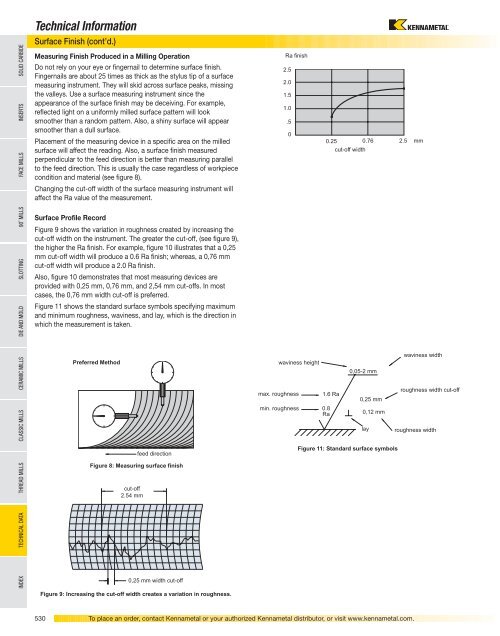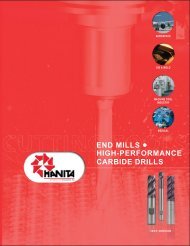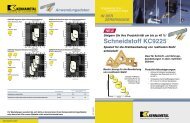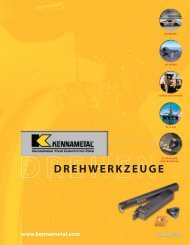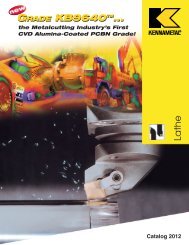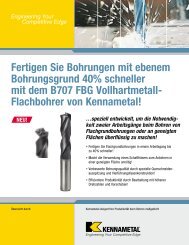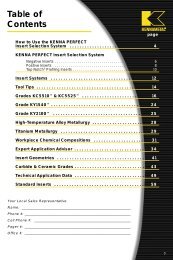- Page 2 and 3:
• • • • • • •WORLD’
- Page 4 and 5:
2THINK MILLING,THINK KENNAMETAL.
- Page 6 and 7:
WWW.KENNAMETAL.COMOur metalcutting
- Page 8 and 9:
THINK MILLING,THINK KENNAMETAL.
- Page 10 and 11:
THINK MILLING,THINK KENNAMETAL.LING
- Page 12 and 13:
Square End FinishersSOLID CARBIDEIN
- Page 14 and 15:
Ball Nose FinishersCLASSIC MILLS CE
- Page 16 and 17:
Grade DescriptionsSOLID CARBIDEgrad
- Page 18 and 19:
AerospaceKennametal enables leading
- Page 20 and 21:
SOLID CARBIDEHigh-Performance Finis
- Page 22 and 23:
SOLID CARBIDEGeneral Application Fi
- Page 24 and 25:
SOLID CARBIDEGeneral Application Fi
- Page 26 and 27:
SOLID CARBIDEGeneral Application Fi
- Page 28 and 29:
SOLID CARBIDEGeneral Application Fi
- Page 30 and 31:
SOLID CARBIDEINSERTSHigh-Performanc
- Page 32 and 33:
SOLID CARBIDEHigh-Performance Finis
- Page 34 and 35:
SOLID CARBIDEGeneral Application Fi
- Page 36 and 37:
SOLID CARBIDEGeneral Application Fi
- Page 38 and 39:
SOLID CARBIDEGeneral Application Fi
- Page 40 and 41:
SOLID CARBIDEGeneral Application Fi
- Page 42 and 43:
SOLID CARBIDEGeneral Application Fi
- Page 44 and 45:
SOLID CARBIDEHigh-Performance Finis
- Page 46 and 47:
SOLID CARBIDEHigh-Performance Finis
- Page 48 and 49:
SOLID CARBIDEHigh-Performance Finis
- Page 50 and 51:
SOLID CARBIDEHigh-Performance Finis
- Page 52 and 53:
SOLID CARBIDEHigh-Performance Finis
- Page 54 and 55:
SOLID CARBIDEHigh-Performance Finis
- Page 56 and 57:
SOLID CARBIDEHigh-Performance Finis
- Page 58 and 59:
SOLID CARBIDEHigh-Performance Finis
- Page 60 and 61:
Application DataSOLID CARBIDEF2AH..
- Page 62 and 63:
Application DataSOLID CARBIDEF3AH..
- Page 64 and 65:
Application DataSOLID CARBIDEF3AU..
- Page 66 and 67:
Application DataSOLID CARBIDEF2/3AH
- Page 68 and 69:
Application DataSOLID CARBIDEF3AJ..
- Page 70 and 71:
Application DataSOLID CARBIDEF1AA..
- Page 72 and 73:
Application DataSOLID CARBIDEF4AS..
- Page 74 and 75:
Application DataSOLID CARBIDEF6/8AJ
- Page 76 and 77:
Square End Mills —Roughing & Semi
- Page 78 and 79:
SOLID CARBIDEINSERTSHigh-Performanc
- Page 80 and 81:
SOLID CARBIDEINSERTSHigh-Performanc
- Page 82 and 83:
SOLID CARBIDEINSERTSHigh-Performanc
- Page 84 and 85:
SOLID CARBIDEINSERTSHigh-Performanc
- Page 86 and 87:
SOLID CARBIDEINSERTSHigh-Performanc
- Page 88 and 89:
SOLID CARBIDEINSERTSHigh-Performanc
- Page 90 and 91:
SOLID CARBIDEINSERTSHigh-Performanc
- Page 92 and 93:
Application DataSOLID CARBIDEF3/4BH
- Page 94 and 95:
Application DataSOLID CARBIDEF3BA..
- Page 96 and 97:
SOLID CARBIDEHigh-Performance Ball
- Page 98 and 99:
SOLID CARBIDEHigh-Performance Ball
- Page 100 and 101:
SOLID CARBIDEHigh-Performance Ball
- Page 102 and 103:
SOLID CARBIDEGeneral Application Ba
- Page 104 and 105:
SOLID CARBIDEHigh-Performance Ball
- Page 106 and 107:
SOLID CARBIDEHigh-Performance Ball
- Page 108 and 109:
SOLID CARBIDEGeneral Application Ba
- Page 110 and 111:
SOLID CARBIDEGeneral Application Ba
- Page 112 and 113:
SOLID CARBIDEGeneral Application Ba
- Page 114 and 115:
SOLID CARBIDEINSERTSHigh-Performanc
- Page 116 and 117:
SOLID CARBIDEINSERTSHigh-Performanc
- Page 118 and 119:
Application DataSOLID CARBIDEF2AL..
- Page 120 and 121:
Application DataSOLID CARBIDEF4AL..
- Page 122 and 123:
Application DataSOLID CARBIDEF2AL..
- Page 124 and 125:
Application DataSOLID CARBIDEF3AW..
- Page 126 and 127:
SOLID CARBIDESpecialty Application
- Page 128 and 129:
SOLID CARBIDESpecialty Application
- Page 130 and 131:
SOLID CARBIDESpecialty Application
- Page 132 and 133:
SOLID CARBIDESpecialty Application
- Page 134 and 135:
SOLID CARBIDESpecialty Application
- Page 136 and 137:
SOLID CARBIDESpecialty Application
- Page 138 and 139:
Application DataSOLID CARBIDEF2AT..
- Page 140 and 141:
Application DataSOLID CARBIDEF6/8AJ
- Page 142 and 143:
Technical NotesSOLID CARBIDEINSERTS
- Page 144 and 145:
Technical NotesSOLID CARBIDECutting
- Page 146 and 147:
Technical Notes90˚ MILLSFACE MILLS
- Page 148 and 149:
THINK MILLING,THINK KENNAMETAL.LING
- Page 150 and 151:
THINK MILLING,THINK KENNAMETAL.INGM
- Page 152 and 153:
Application Selection StepsSOLID CA
- Page 154 and 155:
Application Selection StepsSOLID CA
- Page 156 and 157:
IN MILLINGKennametal “M” Grade
- Page 158 and 159:
Grade DescriptionsSOLID CARBIDEgrad
- Page 160 and 161:
METAL DUROINSERTOSFRESAS DE FACEARF
- Page 162 and 163:
Milling InsertsSOLID CARBIDE first
- Page 164 and 165:
Milling InsertsSOLID CARBIDE first
- Page 166 and 167:
Milling InsertsSOLID CARBIDE first
- Page 168 and 169:
Milling InsertsSOLID CARBIDE first
- Page 170 and 171:
Milling InsertsSOLID CARBIDE first
- Page 172 and 173:
Milling InsertsSOLID CARBIDE first
- Page 174 and 175:
Milling InsertsSOLID CARBIDE first
- Page 176 and 177:
Milling InsertsSOLID CARBIDE first
- Page 178 and 179:
Milling InsertsSOLID CARBIDE first
- Page 180 and 181:
Milling InsertsSOLID CARBIDE first
- Page 182 and 183:
Milling InsertsSOLID CARBIDE first
- Page 184 and 185:
Milling InsertsSOLID CARBIDE first
- Page 186 and 187:
Milling InsertsSOLID CARBIDE first
- Page 188 and 189:
Milling InsertsSOLID CARBIDE first
- Page 190 and 191:
Milling InsertsSOLID CARBIDE first
- Page 192 and 193:
Milling InsertsSOLID CARBIDE first
- Page 194 and 195:
Milling InsertsSOLID CARBIDE first
- Page 196 and 197:
Milling InsertsSOLID CARBIDE first
- Page 198 and 199:
Milling InsertsSOLID CARBIDE first
- Page 200 and 201:
Milling InsertsSOLID CARBIDE first
- Page 202 and 203:
Milling InsertsSOLID CARBIDE first
- Page 204 and 205:
Milling InsertsSOLID CARBIDE first
- Page 206 and 207:
Milling InsertsSOLID CARBIDE first
- Page 208 and 209:
Milling InsertsSOLID CARBIDE first
- Page 210 and 211:
Milling InsertsSOLID CARBIDE first
- Page 212 and 213:
Milling InsertsSOLID CARBIDE first
- Page 214 and 215:
Milling InsertsSOLID CARBIDE first
- Page 216 and 217:
Milling InsertsSOLID CARBIDE first
- Page 218 and 219:
Milling InsertsSOLID CARBIDE first
- Page 220 and 221:
Milling InsertsSOLID CARBIDE first
- Page 222 and 223:
Milling InsertsSOLID CARBIDE first
- Page 224 and 225:
Milling InsertsSOLID CARBIDE first
- Page 226 and 227:
Milling InsertsSOLID CARBIDE first
- Page 228 and 229:
Milling InsertsSOLID CARBIDE first
- Page 230 and 231:
Milling InsertsSOLID CARBIDE first
- Page 232 and 233:
Milling InsertsSOLID CARBIDE first
- Page 234 and 235:
Milling InsertsSOLID CARBIDE first
- Page 236 and 237:
Milling InsertsSOLID CARBIDE first
- Page 238 and 239:
Milling InsertsSOLID CARBIDE first
- Page 240 and 241:
Milling InsertsSOLID CARBIDE first
- Page 242 and 243:
Milling InsertsSOLID CARBIDE first
- Page 244 and 245:
Milling InsertsSOLID CARBIDE first
- Page 246 and 247:
Milling InsertsSOLID CARBIDE first
- Page 248 and 249:
Milling InsertsSOLID CARBIDE first
- Page 250 and 251:
Milling InsertsSOLID CARBIDE first
- Page 252 and 253:
Milling InsertsSOLID CARBIDE first
- Page 254 and 255:
Milling InsertsSOLID CARBIDE first
- Page 256 and 257:
Milling InsertsSOLID CARBIDE first
- Page 258 and 259:
Milling InsertsSOLID CARBIDE first
- Page 260 and 261:
Milling InsertsSOLID CARBIDE first
- Page 262 and 263:
Milling InsertsSOLID CARBIDE first
- Page 264 and 265:
Milling InsertsSOLID CARBIDE first
- Page 266 and 267:
Milling InsertsSOLID CARBIDE first
- Page 268 and 269:
Milling InsertsSOLID CARBIDE first
- Page 270 and 271:
Milling InsertsSOLID CARBIDE first
- Page 272 and 273:
Milling InsertsSOLID CARBIDE first
- Page 274 and 275:
Milling InsertsSOLID CARBIDE first
- Page 276 and 277:
Milling InsertsSOLID CARBIDE first
- Page 278 and 279:
Milling InsertsSOLID CARBIDE first
- Page 280 and 281:
Milling InsertsSOLID CARBIDE first
- Page 282 and 283:
Milling InsertsSOLID CARBIDE first
- Page 284 and 285:
Milling InsertsSOLID CARBIDE first
- Page 286 and 287:
THINK MILLING,THINK KENNAMETAL.LING
- Page 288 and 289:
How to Determine Speeds and FeedsIN
- Page 290 and 291:
SOLID CARBIDEDodeka 45°Indexable I
- Page 292 and 293:
SOLID CARBIDEINSERTSFACE MILLSDodek
- Page 294 and 295:
SOLID CARBIDEINSERTSKSOM MiniIndexa
- Page 296 and 297:
SOLID CARBIDEINSERTSKSOM Mini Face
- Page 298 and 299:
KSOM MiniSLOTTING90˚ MILLSFACE MIL
- Page 300 and 301:
SOLID CARBIDEINSERTSKSOMIndexable I
- Page 302 and 303:
90˚ MILLSFACE MILLSINSERTSSOLID CA
- Page 304 and 305:
SOLID CARBIDEINSERTSKSOM Applicatio
- Page 306 and 307:
SOLID CARBIDEINSERTSFACE MILLSKSSM
- Page 308 and 309:
KSSM 45˚SLOTTING90˚ MILLSFACE MIL
- Page 310 and 311:
SOLID CARBIDEINSERTSFACE MILLSKSSM
- Page 312 and 313:
KSSM 75ºSLOTTING90˚ MILLSFACE MIL
- Page 314 and 315:
SOLID CARBIDECast Iron Machining -
- Page 316 and 317:
SOLID CARBIDEINSERTSFACE MILLSFIX-P
- Page 318 and 319:
SOLID CARBIDEINSERTSFIX-PERFECT 70
- Page 320 and 321:
FIX-PERFECT 70° — Cast IronSLOTT
- Page 322 and 323:
SOLID CARBIDEINSERTSFIX-PERFECT —
- Page 324 and 325:
SOLID CARBIDEFIX-PERFECT — Cast I
- Page 326 and 327:
SOLID CARBIDEHexaCut SeriesIndexabl
- Page 328 and 329:
SOLID CARBIDEINSERTSFACE MILLSHexaC
- Page 330 and 331:
SOLID CARBIDEHexaCut 45° — Cast
- Page 332 and 333:
SOLID CARBIDEINSERTSFACE MILLSHexaC
- Page 334 and 335:
SOLID CARBIDEHexaCut 60° — Cast
- Page 336 and 337:
SOLID CARBIDEHexaCut 60° — Cast
- Page 338 and 339:
SOLID CARBIDEHexaCut 60° — Cast
- Page 340 and 341:
SOLID CARBIDEHexaCut SeriesAdjustme
- Page 342 and 343:
SOLID CARBIDEINSERTSKSSRIndexable I
- Page 344 and 345:
KSSRIndexable Shell Mills for Steel
- Page 346 and 347:
SOLID CARBIDEKSCM AluMillCartridges
- Page 348 and 349:
KSCM AluMillSLOTTING90˚ MILLSFACE
- Page 350 and 351:
KSCM AluMillCutter Cartridge Assemb
- Page 352 and 353:
SOLID CARBIDEINSERTSKSCM AluMillIns
- Page 354 and 355:
SOLID CARBIDEINSERTSKENDEX Mini Mil
- Page 356 and 357:
KENDEX Mini Mill — AluminiumSLOTT
- Page 358 and 359:
SOLID CARBIDEINSERTSFACE MILLSChamf
- Page 360 and 361:
Chamfer MillsSLOTTING90˚ MILLSFACE
- Page 362 and 363:
THINK MILLING,THINK KENNAMETAL.LING
- Page 364 and 365:
90˚ MILLSFACE MILLSINSERTSSOLID CA
- Page 366 and 367:
SOLID CARBIDENGE-AIndexable End Mil
- Page 368 and 369:
SLOTTING90˚ MILLSFACE MILLSINSERTS
- Page 370 and 371:
90˚ MILLSFACE MILLSINSERTSSOLID CA
- Page 372 and 373:
Mill 1-14SLOTTING90˚ MILLSFACE MIL
- Page 374 and 375:
THREAD MILLS CLASSIC MILLS CERAMIC
- Page 376 and 377:
CERAMIC MILLS DIE AND MOLDSLOTTING9
- Page 378 and 379:
90˚ MILLSFACE MILLSINSERTSSOLID CA
- Page 380 and 381:
SOLID CARBIDEINSERTSMill 1 — MaxI
- Page 382 and 383:
90˚ MILLSFACE MILLSINSERTSSOLID CA
- Page 384 and 385:
KSSM 90° - IC 10 mmSOLID CARBIDERe
- Page 386 and 387:
SOLID CARBIDEKSSM 90° — IC 12 mm
- Page 388 and 389:
CERAMIC MILLS DIE AND MOLDSLOTTING9
- Page 390 and 391:
KSSM 90º — IC 12 mmSLOTTING90˚
- Page 392 and 393:
SOLID CARBIDEFIX-PERFECT 90° — C
- Page 394 and 395:
SOLID CARBIDEFIX-PERFECT 90° — C
- Page 396 and 397:
FIX-PERFECT 90° — Cast IronSLOTT
- Page 398 and 399:
SOLID CARBIDEFIX-PERFECT — Alumin
- Page 400 and 401:
SOLID CARBIDEFIX-PERFECT — Alumin
- Page 402 and 403:
SOLID CARBIDEFIX-PERFECT — Alumin
- Page 404 and 405:
FIX-PERFECT — AluminiumSLOTTING90
- Page 406 and 407:
THINK MILLING,THINK KENNAMETAL.LING
- Page 408 and 409:
SOLID CARBIDEINSERTSFACE MILLSA2Ind
- Page 410 and 411:
A2Very Narrow Slotting CuttersSOLID
- Page 412 and 413:
SOLID CARBIDEINSERTS90° SN Slottin
- Page 414 and 415:
SOLID CARBIDEINSERTS90° LN Slottin
- Page 416 and 417:
DIE AND MOLDSLOTTING90˚ MILLSFACE
- Page 418 and 419:
SOLID CARBIDEKSSM Slotting Cutters
- Page 420 and 421:
90˚ MILLSFACE MILLSINSERTSSOLID CA
- Page 422 and 423:
90˚ MILLSFACE MILLSINSERTSSOLID CA
- Page 424 and 425:
90˚ MILLSFACE MILLSINSERTSSOLID CA
- Page 426 and 427:
SOLID CARBIDEINSERTSKSSM Slotting C
- Page 428 and 429:
90˚ MILLSFACE MILLSINSERTSSOLID CA
- Page 430 and 431:
90˚ MILLSFACE MILLSINSERTSSOLID CA
- Page 432 and 433:
90˚ MILLSFACE MILLSINSERTSSOLID CA
- Page 434 and 435:
KSSM Slotting Cutters — IC 12 —
- Page 436 and 437:
Die-and-MoldKennametal enables die-
- Page 438 and 439:
SOLID CARBIDEKSWM — KenFEEDIndexa
- Page 440 and 441:
CERAMIC MILLS DIE AND MOLDSLOTTING9
- Page 442 and 443:
KSWM — KenFEEDSLOTTING90˚ MILLSF
- Page 444 and 445:
SOLID CARBIDEINSERTSKMSIndexable In
- Page 446 and 447:
KMSSLOTTING90˚ MILLSFACE MILLSINSE
- Page 448 and 449:
SOLID CARBIDEINSERTSFACE MILLSKMM S
- Page 450 and 451:
SOLID CARBIDEINSERTSFACE MILLSKMM S
- Page 452 and 453:
SOLID CARBIDEKMM Screw-On End Mills
- Page 454 and 455:
SOLID CARBIDEINSERTSFACE MILLSKDM R
- Page 456 and 457:
SOLID CARBIDEINSERTSFACE MILLSKDM R
- Page 458 and 459:
SOLID CARBIDEKDM RD.X10Indexable In
- Page 460 and 461:
SOLID CARBIDEKDM RD.X 12Indexable I
- Page 462 and 463:
SOLID CARBIDEKDM RD.X16Indexable In
- Page 464 and 465:
KDM RD.X07SLOTTING90˚ MILLSFACE MI
- Page 466 and 467:
KDM RD.X12SLOTTING90˚ MILLSFACE MI
- Page 468 and 469:
SOLID CARBIDEINSERTSFACE MILLSKSRMI
- Page 470 and 471:
SOLID CARBIDEKDMBIndexable Inserts
- Page 472 and 473:
SLOTTING90˚ MILLSFACE MILLSINSERTS
- Page 474 and 475:
KDMBSOLID CARBIDERecommended Starti
- Page 476 and 477:
KDMBSOLID CARBIDEINSERTSRecommended
- Page 478 and 479:
KDMBSOLID CARBIDEINSERTSRecommended
- Page 480 and 481:
SOLID CARBIDEKDMS and KDMTIndexable
- Page 482 and 483: SOLID CARBIDEINSERTSKDMT and KDMSFl
- Page 484 and 485: THINK MILLING,THINK KENNAMETAL.LING
- Page 486 and 487: SOLID CARBIDEINSERTSFACE MILLSKIPR
- Page 488 and 489: SOLID CARBIDEINSERTSKSSR — RNInde
- Page 490 and 491: Screw-On Extensions for Modular Scr
- Page 492 and 493: THINK MILLING,THINK KENNAMETAL.LING
- Page 494 and 495: SOLID CARBIDEINSERTSFIX-PERFECT —
- Page 496 and 497: SOLID CARBIDE90° CN Slotting Cutte
- Page 498 and 499: SOLID CARBIDEFIX-PERFECT Half-Side
- Page 500 and 501: SOLID CARBIDEINSERTSRPF MillsRPF 90
- Page 502 and 503: THINK MILLING,THINK KENNAMETAL.LING
- Page 504 and 505: TECHNICAL DATA THREAD MILLS CLASSIC
- Page 506 and 507: SLOTTING90˚ MILLSFACE MILLSINSERTS
- Page 508 and 509: SOLID CARBIDETMS — Thread Milling
- Page 510 and 511: SOLID CARBIDEApplication and Techni
- Page 512 and 513: INDEXTECHNICAL DATA THREAD MILLS CL
- Page 514 and 515: THREAD MILLS CLASSIC MILLS CERAMIC
- Page 516 and 517: SOLID CARBIDEINSERTSTMS — Thread
- Page 518 and 519: 90˚ MILLSFACE MILLSINSERTSSOLID CA
- Page 520 and 521: SOLID CARBIDEINSERTSFACE MILLSTechn
- Page 522 and 523: Technical Information90˚ MILLSFACE
- Page 524 and 525: 90˚ MILLSFACE MILLSINSERTSSOLID CA
- Page 526 and 527: 90˚ MILLSFACE MILLSINSERTSSOLID CA
- Page 528 and 529: SLOTTING90˚ MILLSFACE MILLSINSERTS
- Page 530 and 531: DIE AND MOLDSLOTTING90˚ MILLSFACE
- Page 534 and 535: SOLID CARBIDEINSERTSTechnical Infor
- Page 536 and 537: SOLID CARBIDETechnical InformationT
- Page 538 and 539: Conversion ChartsDIE AND MOLDSLOTTI
- Page 540 and 541: Conversion ChartsINDEXTECHNICAL DAT
- Page 542 and 543: Technical DataSOLID CARBIDEINSERTSF
- Page 544 and 545: GlossaryINDEXTECHNICAL DATA THREAD
- Page 546 and 547: GlossaryINDEX TECHNICAL DATA THREAD
- Page 548 and 549: TECHNICAL DATA THREAD MILLS CLASSIC
- Page 550 and 551: TECHNICAL DATA THREAD MILLS CLASSIC
- Page 552 and 553: CERAMIC MILLS DIE AND MOLDSLOTTING9
- Page 554 and 555: To place an order, contact Kennamet
- Page 556 and 557: To place an order, contact Kennamet
- Page 558 and 559: To place an order, contact Kennamet
- Page 560 and 561: To place an order, contact Kennamet
- Page 562 and 563: Index By Order NumberINDEXTECHNICAL
- Page 564 and 565: Index By Order NumberINDEXTECHNICAL
- Page 566 and 567: Product ListingPage(s)16A2R026B16SA
- Page 568 and 569: Product ListingPage(s)63A06RP90SP12
- Page 570 and 571: Product ListingPage(s)F2AH0300BDL30
- Page 572 and 573: Product ListingPage(s)F3AH0700BDL30
- Page 574 and 575: Product ListingPage(s)F4AT0600AWL20
- Page 576 and 577: Product ListingPage(s)MW3 . . . . .
- Page 578 and 579: Product ListingPage(s)SPGN120408T K
- Page 580: Subsidiaries/Sales OfficesAUSTRIAKe


